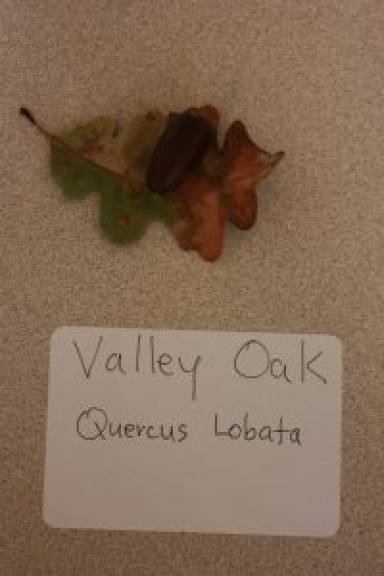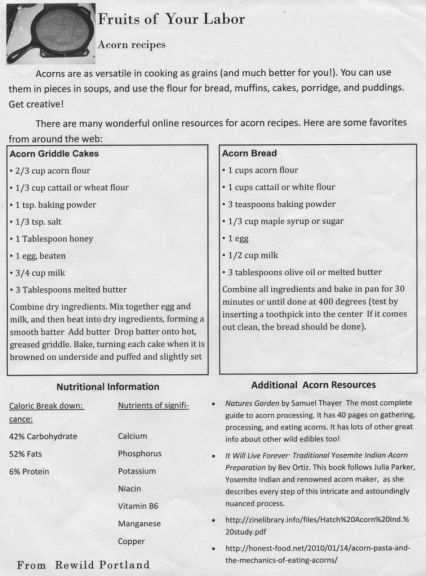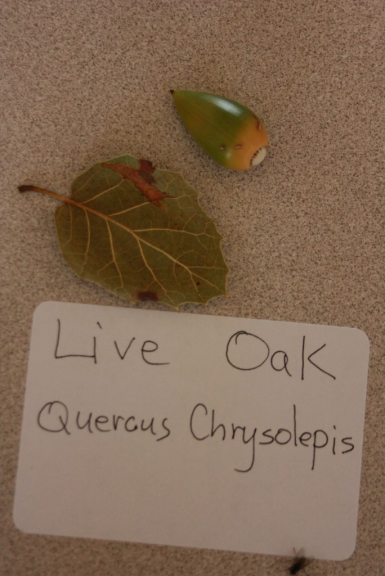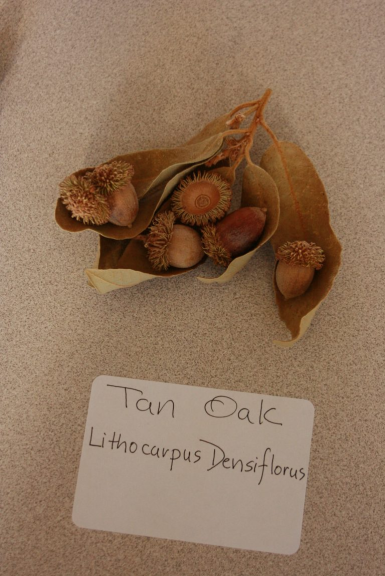Farmers and Gatherers Acorn Project
This project is not suitable for ELDP groups to do at Metini / Fort Ross, as there will be insufficient time to process acorns in a single-day program. However, this project can be a lot of fun and interested ELDP Farmers & Gatherers groups can do this project before coming to Metini / Fort Ross, or doing part of it on site and part in the classroom.
 Perhaps you’ve walked past a large Oak Tree that has dropped hundreds of acorns. You see squirrels busily collecting these little treasures and you wonder what they find so interesting about them? For the Kashia Pomo, acorns were a main food staple. In this project, you will discover a new taste and you will use the same — or similar — methods the Kashia used to turn these little gifts into a nutritious breakfast food.
Perhaps you’ve walked past a large Oak Tree that has dropped hundreds of acorns. You see squirrels busily collecting these little treasures and you wonder what they find so interesting about them? For the Kashia Pomo, acorns were a main food staple. In this project, you will discover a new taste and you will use the same — or similar — methods the Kashia used to turn these little gifts into a nutritious breakfast food.
Important – Gathering acorns is a seasonal activity. Acorns will start dropping in late August. This is called the ‘first flush’, and these first acorns are what the tree is discarding because of disease, etc. Wait for the ‘second flush’, which happens a little later in the season when a stiff autumnal wind shakes the acorns loose from the tree. Healthy acorns do not have caps. And, the crown where the cap once lived is fleshy — not dehydrated. Also the hull is free of wormholes. Make certain you are not using anything plastic for storage. Collect and store your acorns in a way that allows for plenty of air circulation. This will help to ensure your acorns do not rot or get moldy. Plan accordingly!
Please note – This project requires that each activity group participates in the care and processing of the acorns during their Night Watch. Continue reading for more details.
What you will need to bring:
3 – 6 Plastic or metal bowls to hold shelled acorns, shells, and acorn meal
1 yard of thin unbleached muslin fabric - as seen here, or a clean pillowcase free of detergents for every variety of acorn you bring. If you collect two or more types of acorns, you should keep each type separate. So bring as many pillowcases/pieces of fabric as types of acorn you collect and plan to process
To make a simple sack for your acorn meal, cut a rectangle 24″ x 12″. Fold the 24″ of the rectangle in half. Stitch along the folded edges on both sides to create a bag. Fold over 1/2″ at the top of the bag; stitch all the way around. Turn bag right side out. Use a thin piece of twine 24″ long. Insert a small safety pin in the end of the twine and begin threading the twine into the 1/2″ fold at the top of the bag
Your pre-collected and sorted acorns — we recommend 2 1-gallon ziplock bags filled. When collecting acorns make sure to discard the following –
- Discard acorns that have attached caps
- Discard acorns that have worm holes
- Discard acorns that have mold
- Discard acorns that have large cracks
Note – You cannot gather acorns at Metini / Fort Ross! When you start processing acorns on site, you may find that a number of acorns that looked OK are actually bad and need to be discarded. Keep this in mind so that you collect enough acorns to bring to Metini / Fort Ross
Tip: Bring an additional stash of flour to add to your acorn meal if you end up with a shortage for your chosen recipe. This doesn’t have to be acorn flour, but whichever flour you choose. Perhaps the Cooks can help you with recipe selection
All other ingredients for your chosen acorn recipe. It is most likely you’ll be tasting your acorn creation during your morning meal. You can use the recipes provided below or find your own. Acorn pancakes are a treat!
What will be provided to you by your ELP Instructor –
- Mallets for cracking — coordinate with the Artisans as needed
- Three mortar and pestles
- Mesh strainers for sifting
- A colander and bowl for leaching acorn tannins overnight
Gathering, Storing & Preparations – Follow these instructions before coming to Metini / Fort Ross.
How to Make Acorn Meal – Follow these instructions while you are at Metini / Fort Ross. Acorns must be sorted, cracked, and leached for at least three hours before they are safe to eat! The amount of time it takes to ready your acorns for leaching depends on how many acorns you have and how finely you want to grind your acorn meal. Try to plan your project time accordingly.
Crack acorns open using your mallet. Collect acorn hulls and later take these to the compost pile
Strip seed coat off each nut – this gets easier once they sit in the sun for a few minutes
Put edible nuts into mortar & pestles to start grinding. Discard any bad acorns that have mold, bugs or bug damage
Using the mortar and pestles grind the nuts to a fine meal consistency. As you grind, there will be some finely ground meal and some larger pieces. Using a mesh strainer, sift the fine meal into a bowl set aside for the finished nut meal. You will be left with larger pieces of nuts to re-grind. Grind down and repeat the process of sifting until all is a fine ground meal. Measure out dry acorn flour based on your chosen recipe prior to leaching
Fresh acorns have a high water content. As you work, the mortar and pestle draws out the water and the ground meal becomes more of the dry flour consistency you’re used to seeing
Set up your sack of acorn meal in the colander and container, and add water to start the leaching process
The water should be changed as regularly as possible. If time allows, Farmers & Gatherers should change the water by draining out the old water and adding in clean water, one or two times before bedtime. Then each role group will need to follow the same leaching process, by emptying out old water and adding clean water as part of their Night Watch responsibilities. It is not a problem that the meal will be wet in the morning. Use the muslin bag to squeeze out excess water before adding to other ingredients of your recipe
The Farmers & Gatherers will provide the rest of the class with leaching instructions, so that each group takes a turn emptying and adding fresh water during their Night Watch shift. It’s important for each group to participate so that the tannins are properly leached and the acorn meal is ready to cook in the morning
Cooking Your Acorn Meal – The more acorn meal you make, the more you can cook up for your class. Acorn meal will be cooked in the morning, after it has been properly leached. You can use the following griddle cake recipe — from Rewild Portland: Environmental Education through Earth-based Arts, Traditions, and Technologies — to cook your acorn meal at Metini / Fort Ross, or follow another recipe of your choosing. Please note you will not be able to bake bread at Metini / Fort Ross! If you’d like to make acorn bread, we encourage you to do this as an additional project at home. Please also remember to coordinate with the Cooks, so all cooking runs smoothly and is completed by your class’s scheduled breakfast.



Shown below – The Kashia Pomo have gathered acorns from the local Tan Oaks trees for thousands of years.
For more information, check out these articles –